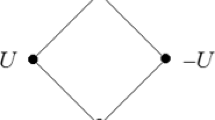Abstract
In this paper, we provide a semantic study of the first-order predicate logic for situations involving uncertainty. We introduce the concepts of uncertain predicate proposition, uncertain predicate formula, uncertain interpretation and degree of truth in the framework of uncertainty theory. Compared with classical predicate formula taking true value in \(\{0,1\}\), the degree of truth of uncertain predicate formula may take any value in the unit interval \([0,1]\). We also show that the uncertain first-order predicate logic is consistent with the classical first-order predicate logic on some laws of the degree of truth.
Similar content being viewed by others
Explore related subjects
Discover the latest articles, news and stories from top researchers in related subjects.References
Adams, E. (1998). A primer of probability logic. Stanford: CSLI Pulications.
Campos, C., Cozman, F., & Luna, J. (2009). Assembling a consistent set of sentences in relational probabilistic logic with stochastic independence. Journal of Applied Logic, 7(2), 137–154.
Chen, X., & Ralescu, D. A. (2011). A note on truth value in uncertain logic. Expert Systems with Applications, 38(12), 15582–15586.
Cignoli, R., Esteva, F., Godo, L., & Torreas, A. (2000). Basic fuzzy logic is the logic of continuous t-norms and their residua. Soft Computing, 4(2), 106–112.
Coletti, G., & Scozzafava, R. (2002). Probability logic in a coherent setting. London: Kluwer.
Dubois, D., & Prade, H. (1987). Necessity measure and resolution principle. IEEE Transactions on Man Cybenet, 17(3), 474–478.
Esteva, F., & Godo, L. (2001). Monoidal t-norm based logic: towards logic for left-continuous t-norms. Fuzzy Sets and Systems, 124(3), 271–288.
Gödel, K. (1932). Zum intuitionistischen Aussagenkalköl. Anz. Akad. Wiss. Wien, 69, 65–66.
Hailperin, T. (1996). Sentential probability logic. London: Associated University Presses.
Hajek, P. (1998). Metamathematics of fuzzy logic. London: Kluwer.
Li, X., & Liu, B. (2009a). Foundation of credibilistic logic. Fuzzy Optimization and Decision Making, 8(1), 91–102.
Li, X., & Liu, B. (2009b). Hybrid logic and uncertain logic. Journal of Uncertain Systems, 3(2), 83–94.
Liu, B. (2007). Uncertainty theory (2nd ed.). Berlin: Springer.
Liu, B. (2009a). Some research problems in uncertainty theory. Journal of Uncertain Systems, 3(1), 3–10.
Liu, B. (2009b). Uncertain entailment and modus ponens in the framework of uncertain logic. Journal of Uncertain System, 3(4), 243–251.
Liu, B. (2010). Uncertainty theory: A branch of mathematics for modeling human uncertainty. Berlin: Springer.
Liu, B. (2013). Uncertainty theory, 4th Edn. http://orsc.edu.cn/liu.
Nilsson, N. (1986). Probability logic. Artificial Intelligence, 28, 71–78.
Pei, D. (2003). On equivalent forms of fuzzy logic systems NM and IMTL. Fuzzy Sets and Systems, 138(1), 187–195.
Wang, G. (1997). A formal deduction system of fuzzy propositional calculation. Science in China Series E-information Sciences, 42(10), 1041–1044.
Wang, S., & Wang, M. (2006). Disjunctive elimination rule and its application in MTL. Fuzzy Sets and Systems, 157, 3169–3176.
Acknowledgments
We would like to express our gratitude to both the editor and the anonymous reviewers for their valuable comments that significantly improved the quality of this paper. This work was supported by National Natural Science Foundation of China (Nos. 61273044, 71101007, 71371027), Program for New Century Excellent Talents in University under Grant No. NCET-13-0649, and the Fundamental Research Funds for the Central Universities (No. ZZ1316)
Author information
Authors and Affiliations
Corresponding author
Appendix: Classical logic
Appendix: Classical logic
The section recalls some basic concepts and results about classical propositional logic and first-order predicate logic.
Let \(X\) be a formula containing propositions \(p_{1}, p_{2},\ldots ,p_{n}\). Then there is a Boole function \(f: \{0,1\}^{n}\rightarrow \{0,1\}\) such that \(T(X)=1\) if and only if \(f(x_{1}, x_{2},\ldots ,x_{n})=1\) where \(x_i=T(p_i)\) for \(i=1,2,\ldots ,n\). For simplicity, we denote the Boole function of formula \(X\) as \(f_{X}\).
Definition (a)
A formula \(X\) is called a tautology, denoted by \( \models X\), if \( f_{X}(x_{1},x_{2},\ldots , x_{n})=1\) for all \((x_{1},x_{2},\ldots ,x_{n})\in \{0,1\}^{n}.\)
Definition (b)
A formula \(X\) is said to be contradiction, denoted by \(\models \lnot X\), if \( f_{X}(x_{1},x_{2},\ldots ,x_{n})=0\) for all \((x_{1},x_{2},\ldots ,x_{n})\in \{0,1\}^{n}.\)
Definition (c)
Formulae \(X\) and \(Y\) are called semantically equivalent, denoted by \(X \equiv Y\), if \(f_{X}(x_{1},x_{2},\) \(\cdots ,x_{n})=f_{Y}(x_{1},x_{2},\ldots ,x_{n})\) for all \((x_{1},x_{2},\ldots ,x_{n})\in \{0,1\}^{n}.\)
Definition (d)
Let \(X\) be a formula containing propositions \(p_{1}, p_{2},\ldots ,p_{n}\). It is said to be a disjunctive normal form if
where \(Q_{ij} \) is either \(p_{j}\) or \( \lnot p_{j}\) for \(i=1,2,\ldots ,m,j=1,2,\ldots ,n.\)
Theorem (a)
Let \(X\) be a formula containing propositions \(p_{1}, p_{2},\ldots ,p_{n}\). Then it is semantically equivalent to a disjunctive normal form as follows:
where for each \((x_{1},x_{2},\ldots ,x_{n})\in \{0,1\}^{n}\) with \(f_{X}(x)=1\), \(Q_{x_i}=p_{i}\) if \(x_{i}=1\) and \(Q_{x_i}=\lnot p_{i}\) if \(x_{i}=0\).
The disjunctive normal form of \(X\) is denoted by \(G(X)\). For example, \(G(p_{1}\wedge p_{2}\rightarrow p_{3})=(\lnot p_{1}\wedge p_{2}\wedge \lnot p_{3})\vee ( p_{1}\wedge \lnot p_{2}\wedge \lnot p_{3})\vee (\lnot p_{1}\wedge \lnot p_{2}\wedge \lnot p_{3}) \vee (p_{1}\wedge p_{2}\wedge \lnot p_{3})\vee (\lnot p_{1}\wedge p_{2}\wedge \lnot p_{3})\vee (p_{1}\wedge \lnot p_{2}\wedge \lnot p_{3})\vee (\lnot p_{1}\wedge \lnot p_{2}\wedge \lnot p_{3})\).
Rights and permissions
About this article
Cite this article
Zhang, X., Li, X. A semantic study of the first-order predicate logic with uncertainty involved. Fuzzy Optim Decis Making 13, 357–367 (2014). https://doi.org/10.1007/s10700-014-9184-2
Published:
Issue Date:
DOI: https://doi.org/10.1007/s10700-014-9184-2




